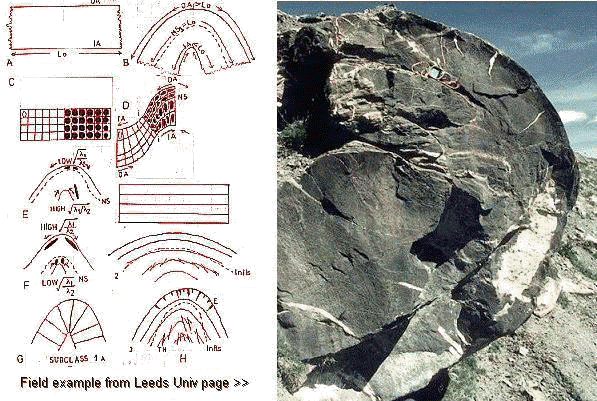| TANGENTIAL LONGITUDINAL STRAIN
Mechanism by which principal finite strains lie tangential to the fold arcs, positive at outer and negative at inner leading to outer arcs getting extended and inner shortened. This is the mechanism of fold formation in which there is internal deformation within the layers unlike the flexural slip folds in which the shortening of the complex is achieved by sliding of the layers alone. In this type of mechanism, the strains within the folded layers are adjusted in such a manner that the outer arc of a competent layer is extended while the inner arc is shortened. Thus there is extension or stretching acting all along the outer arc tangentially and compression acting all along the inner arc. This also implies that part of the layer is extended and a part of it is contracted to keep the orthogoral thickess more or less constant throughout the folded layer. The boundary that divides the zone or part of the layer that undergoes extension from the part which undergoes contraction is known as the finite neutral surface. A change in the strain configuration occurs at the inflexion planes also, for across this plane of inflexion extensional field passes over into a contractional field and vice versa. In the extended region of the layer, the long axes of the strain ellipses in fold profile will lie parallel to the outer arc of the folded layer. In the contracted region of the layers the long axes of the strain ellipses lie athwart or subperpendicular to the inner arc of the folded surface. Because all strain whether one of positive or negative extension is tangential to fold arcs the mechanism is termed tangential longitudinal strain. The neutral surface is the surface of no finite longitudinal strain and its position need not exactly lie midway between the zone or portion of extension and that or contraction. The exact position of the neutral surface is determined by the principal strain ratios at the outer arc and at the inner arc. If the strain ratios at the outer arcs are high, it implies that the neutral surface must shift more towards the inner arc (see Figure). If the principal strain ratio at the inner arc region is very high, obviously we should expect the neutral surface to shift more towards the outer arc region. The neutral surface may also cross-cut the fine laminations within the layer at small angle. This is the mechanism of fold formation in which there is internal deformation within the layers unlike the flexural slip folds in which the shortening of the complex is achieved by sliding of the layers alone. In this type of mechanism, the strains within the folded layers are adjusted in such a manner that the outer arc of a competent layer is extended while the inner arc is shortened. Thus there is extension or stretching acting all along the outer arc tangentially and compression acting all along the inner arc. This also implies that part of the layer is extended and a part of it is contracted to keep the orthogoral thickess more or less constant throughout the folded layer. The boundary that divides the zone or part of the layer that undergoes extension from the part which undergoes contraction is known as the finite neutral surface. A change in the strain configuration occurs at the inflexion planes also, for across this plane of inflexion extensional field passes over into a contractional field and vice versa. In the extended region of the layer, the long axes of the strain ellipses in fold profile will lie parallel to the outer arc of the folded layer. In the contracted region of the layers the long axes of the strain ellipses lie athwart or subperpendicular to the inner arc of the folded surface. Because all strain whether one of positive or negative extension is tangential to fold arcs the mechanism is termed tangential longitudinal strain. The neutral surface is the surface of no finite longitudinal strain and its position need not exactly lie midway between the zone or portion of extension and that or contraction. The exact position of the neutral surface is determined by the principal strain ratios at the outer arc and at the inner arc. If the strain ratios at the outer arcs are high, it implies that the neutral surface must shift more towards the inner arc (see Figure). If the principal strain ratio at the inner arc region is very high, obviously we should expect the neutral surface to shift more towards the outer arc region. The neutral surface may also cross-cut the fine laminations within the layer at small angle. |
 |